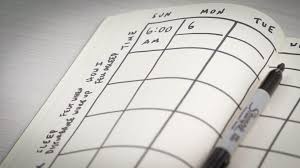Why bother with a sleep diary?
To start with...What is a sleep diary?
Every day, you record when you go to bed .when you wake up throughout the night, what you did before going to sleep, you evaluate your sleep quality, etc..
It works like any diary. It creates awareness.
1) You understand your sleep patterns
2) It makes you aware of what you are not doing right and encourages you to make small changes, one at a time. For me it was the digital activities in my bed ( so hard to give up this one!), the temperature of my bedroom (always too hot), cutting the alcohol in the evening ( this was hard because I only drink in the evening!).
3) It is a way to have a baseline, to check if my changes had actually improved my sleep patterns.
Here is an example of my Sleepio sleep diary...
Manual sleep diary or using a sleep monitor?
In the last 2 weeks, I have tried the sleep app Sleepio then quickly used my brand new Fitbit Versa sleep monitor function. You sync the data into your Sleepio account and you get a precise view of your sleep patterns.
If you are using a manual diary, it is important to do it in the morning, every day, because you can never remember what happened after a few hours. It’s a bit like writing down your dreams.
Going through the different blogs and community discussion, I would say don’t be too obsessive with it as it could make you sleep patterns even worse! And don’t expect it to be 100% accurate.
‘The Sleep Diary is not intended to be an exact science. However, estimates of sleep pattern and quality on a night to night basis build a much more accurate picture than simply having an overall impression. Our impressions are very much influenced by our immediate recent experience. A bad night last night might lead us to think that we are not making any progress or even that we are going backwards. We get a much more balanced and objective picture of how we are sleeping by reviewing information over several nights’
https://www.sleepio.com/
If you are using an online sleep diary, it will also give you a Sleep efficiency results - so how long you actually slept vs the time spent in bed.
By moving to an automatic recording, through my Fitbit, I realised how bad I was at keeping accurate records of my sleep. I actually slept much more than I thought. I easily reached my 7hr goal ( I was on holidays so it was easy) according to my watch when I had recorded only 5 to 6h sleep in my manual diary.
Light, deep sleep and REM?
During the night, we go through sleep cycles of around 90min, made of non-REM sleep ( light and deep) and REMsleep ( high brain activity).
Tracking devices should help you measure them. Beyond the numbers of hours you sleep, it is important to understand if you get your right amount of deep sleep and REM sleep ( we tend to get less as we get older).
The medical futurist is a great source of information on how to use your sleep information.
https://medicalfuturist.com/analyze-sleep-quality/
So after a few weeks, I have realised.
I feel great if I sleep for 7 hours. No need for more.
If my deep and REM sleeps fall below 50%, I don’t feel really restored.
I reach this if: I don’t drink too much in the evening, I’m not too hot, I go to bed before 11 pm, I haven’t watched a film before going to sleep.
I go to bed later in the weekend but my body seems to be capable of recovering. My best nights are during the week.
If I’m worried, if I have a deadline, my sleep really suffers so I need mindfulness techniques to keep my mind at peace.
I’m an early bird (6 am max) so I really need to go to bed early.
During the COVID pandemics, it’s not too hard as we can’t go out!
That’s also the reason why sleep tracking and sleep analysis are very useful.
We can draw conclusions, get better at sleeping and make the most of our day from the next morning. Here is an example of my sleep analysis. You can see how the REM / dream ( in red) activities kick in the middle of the night while deep restorative sleep takes place at the early stages of the night.
That’s also the reason why sleep tracking and sleep analysis are very useful. We can draw long-term conclusions, get better at sleeping and make the most of our day from the next morning. Here is an example of my sleep analysis. You can see how the REM/dream (in red) activities kicks in in the middle of the night while deep, restorative sleep takes place at the early stages of the night.


Comments
Post a Comment